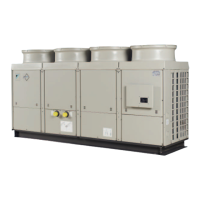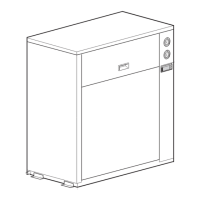Troubleshooting ESIE11-02
3–24 Part 3 – Troubleshooting
3
1
3
4
5
4.2 Items to Be Checked
Introduction The tables below contain the most frequent failures and their corresponding corrective action:
■ In case the unit does not start and there is no malfunction indication.
■ In case the unit does not start and there is a malfunction indication.
No malfunction
indication
The unit does not start and there is no malfunction indication:
Malfunction
indication
The unit does not start and there is a malfunction indication:
Possible causes Items to be checked
Power supply problem:
■ Main supply
■ Control system supply
■ PCB supply (for EUWA*5-24KBZW1
and EUWY*5-24KBZW1)
■ Loose or broken connections
■ Blown fuses (due to short circuit)
■ Defective transformer
The unit is not switched ON.
■ Check the remote start/stop set-up and correct it, if
necessary.
■ In case of remote control, check the field wiring.
One of the timers is still active. Check the timers overview in this manual and wait
until all timers have elapsed. See ‘‘Compressor Tim-
ers” on page 2-9.
The unit is incorrectly programmed. Check the settings.
Malfunction Possible causes Items to be checked
Freeze-up
■ Water flow too low
■ Refrigerant shortage
■ Operation out of range
■ Defective thermostat control
■ Pump operation
■ Water flow (blocked valves)
■ Flow switch operation
■ Operation condition
■ Blocked parts in the refrigerant system
■ Refrigerant leaks
Overcurrent in
the compressor
■ Failure on one of the phases
■ Low supply voltage
■ Motor overload
■ Power supply
■ Fuses
■ Mains isolator switch
■ Mains relay contacts
■ Operation condition
■ Compressor windings
■ Current on all 3 phases
■ Reset the overcurrent relay
High-pressure
switch
■ Defective condenser fan
operation in cooling
■ Dirty or blocked condenser
■ Operation out of range
■ Operation condition
outdoor air temp. < 43°C
■ State of the condenser (clean)

